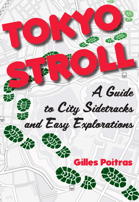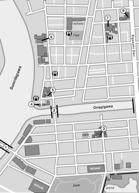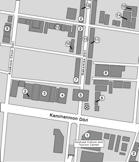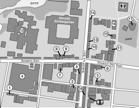











Tokyo Stroll Supplement: Yotsuya Area

This page is for locations in the Yotsuya Area area of Tokyo. This neighborhood is not part of my book Tokyo Stroll.
For information on Tokyo Stroll and this web supplement see Tokyo Stroll Supplement home page
For users of the Organic Maps, Maps.Me and Google Maps apps the items below have bookmarks you can import into those apps to make navigation easier.
Instructions and links are on the Viewing Locations in Organic Maps, Maps.Me, Google Maps, or Google Earth page.
Some entries on this page may include a note that says "Description to be added soon ." These entries are for items I felt should be listed even if the description is not ready to assist those who wish to plan a trip. When possible I included a link to an official web page, I suggest also doing web searchs for more information.
The Yotsuya area of Shinjuku-ku is best known from the classic kabuki play Yotsuya Kaidan, "Yotsuya Ghost Story" Don't expect many large impressive temples and shrines, the ones here tend to be smaller and plentiful. For the purpose of what I include in this strolling area the borders are the Yotsuya Station area on the east, Tokyo Metropolitan Road Route 302 on the north, Shinjuku Gyoen National Garden on the West, then Meiji Jingū Gaien and the Akasaka Imperial Property on the South giving you three large greenery filled areas to relax in. Yotsuya is also dense with temples so you may want to read the descriptions, pick those that most interest you to focus on, and don't get too burned out by the quantity.
Fire Museum (消防博物館)
A six story museum devoted to firefighting in Edo and Tokyo, the official name is a long one the "Tokyo Fire Department Firefighting and Disaster Prevention Reference Center". The building is also the Yotsuya fire station so be careful when approaching the entrance and exiting as vehicles may suddenly be leaving. The displays include equipment and uniforms from the Edo Period to the modern day. Items on display from the Edo Period include: fire resistant clothing, brigade banners, a hand operated water pump, and tools for disassembling buildings to create firebreaks which was one of the major methods to fight fires in the Edo Period. The modern equipment include: horse drawn and early gas powered fire engines, a ladder truck, various hose nozzles, uniforms, instruments of the fire department's band, and helicopters. There are also various various documents, woodblock prints, dioramas, etc. on display. Kids can even don miniature uniforms and enter some vehicles, even get into the helicopter on the roof. The tenth floor lounge has a panoramic view of Tokyo, and the seventh floor has a library. A suggested route is to start on the sixth floor and work your way down to the basement, skipping the second floor which is the fire station.
NEAREST TRAIN/SUBWAY STATION: Yotsuya-sanchōme Station (Tokyo Metro Marunouchi Line)
CLOSED: Mondays, open if Monday is a holiday and then closed on Tuesday. December 29 - January 3 for the New Year’s Holiday
WEB: https://www.tfd.metro.tokyo.lg.jp/eng/e_museum.html
Fishing Culture Museum (釣り文化資料館)
A small specialized free museum devoted to fishing established in 1989 by the founder of the Weekly Fishing News (Shūkan tsuri nyūsu 週刊つりニュース) magazine. Don't expect displays on commercial fishing, the museum is devoted to individual fishing. Much of what is on display is fishing gear such as bamboo fishing poles, lures, baskets for your catch, etc. from all over Japan. There are also humorous dioramas consisting of preserved frogs dressed as people enjoying fishing.
NEAREST TRAIN/SUBWAY STATION: Akebonobashi Station (Toei Shinjuku Line)
CLOSED: Thursday, Friday and New Years.
WEB: https://tsurinews.co.jp/shiryokan
Oiwa Inari Tamiya Shrine (於岩稲荷田宮神社)
In 1825 an off season kabuki play was performed in Edo during the hottest time of the year. Normally the theaters closed and actors fled the city to cooler places. For some reason at authorities decided there should still be performances that year, so while the stars took a break less popular actors had to stay to perform a play that transformed kabuki. This was Tōkaidō Yotsuya Kaidan, a masterpiece of horror that has continually been performed not only on stage but also in movies, TV, and even an anime version. The author Tsuruya Nanboku IV wove a variety of actual, or purported to be actual, events into what became the play with the vengeful ghost Oiwa.
Legend has it that there was a woman named Oiwa from the Tamiya household in Yotsuya whose ghost nearly destroyed the family after being abused by her husband. The legend is in a document called Yotsuya Zatsudan-shū "Idle Talk of Yotsuya" which is owned by the shrine. The shrine by the way is built where the Tamiya home was once located.
A tradition exists where those putting on the play, or a movie version, go to her grave in another part of Tokyo to pay respects or risk serious problems in the production, to be safe some also go to the shrine. Even James S. De Benneville in his 1916 retelling of the tale asks Oiwa to forgive his retelling of the tale.
NEAREST TRAIN/SUBWAY STATION: Yotsuya-sanchōme Station (Tokyo Metro Marunouchi Line)
Suga Jinja (須賀神社)
Formed by the merger of a Gozu tennō shrine and an Inari shrine in the Meiji Period.
The shrine ceiling has paintings of Thirty-Six Immortals of Poetry which were donated to the shrine in 1836. There is a long stairway with its red handrails leading to the shrine where the final scene in the hit movie Your Name takes place.
NEAREST TRAIN/SUBWAY STATION: Yotsuya-sanchōme Station (Tokyo Metro Marunouchi Line), Yotsuya Station (Chūō Line, Chūō-Sōbu Line)
WEB: https://sugajinjya.or.jp
Tokyo Toy Museum (東京おもちゃ美術館)
Very much for kids of all ages, this museum is mainly hands on, with literally thousands of toys and a playground. Located in a three story former elementary school that was built before WWII. The rooms and hallways not only have toys to view and play with but also a workshop room where you can make your own toy. Modern toys, traditional toys, games, toys that teach science, display galleries, a room designed for babies aged 1-2, and of course a museum shop.
NEAREST TRAIN/SUBWAY STATIONS: Yotsuya-sanchōme Station (Tokyo Metro Marunouchi Line), Akebonobashi Station (Toei Shinjuku Line)
WEB: https://art-play.or.jp/ttm/en/
Back to the Tokyo Stroll Supplement home page - Privacy Notice - Back to Gilles' home page
Created October 21, 2022 | Content last updated September 22, 2025